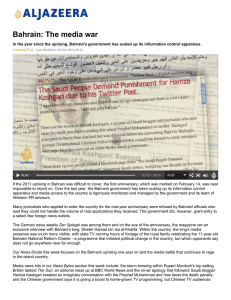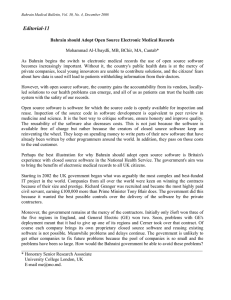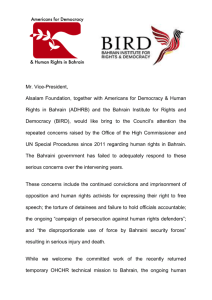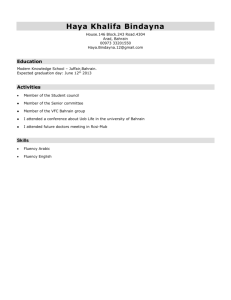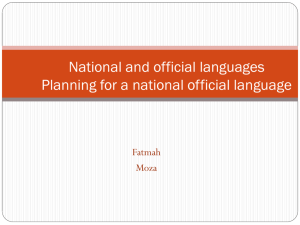S I Opinion A FAILED UPRISING IN BAHRAIN
advertisement
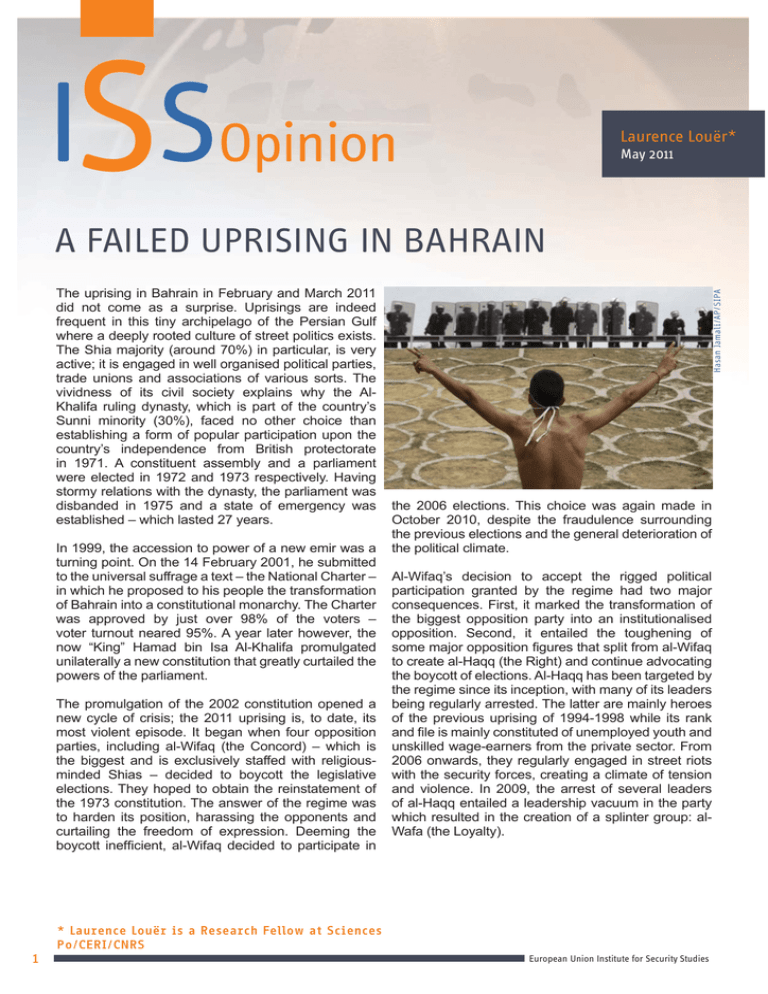
ISSOpinion Laurence Louër* May 2011 The uprising in Bahrain in February and March 2011 did not come as a surprise. Uprisings are indeed frequent in this tiny archipelago of the Persian Gulf where a deeply rooted culture of street politics exists. The Shia majority (around 70%) in particular, is very active; it is engaged in well organised political parties, trade unions and associations of various sorts. The vividness of its civil society explains why the AlKhalifa ruling dynasty, which is part of the country’s Sunni minority (30%), faced no other choice than establishing a form of popular participation upon the country’s independence from British protectorate in 1971. A constituent assembly and a parliament were elected in 1972 and 1973 respectively. Having stormy relations with the dynasty, the parliament was disbanded in 1975 and a state of emergency was established – which lasted 27 years. In 1999, the accession to power of a new emir was a turning point. On the 14 February 2001, he submitted to the universal suffrage a text – the National Charter – in which he proposed to his people the transformation of Bahrain into a constitutional monarchy. The Charter was approved by just over 98% of the voters – voter turnout neared 95%. A year later however, the now “King” Hamad bin Isa Al-Khalifa promulgated unilaterally a new constitution that greatly curtailed the powers of the parliament. The promulgation of the 2002 constitution opened a new cycle of crisis; the 2011 uprising is, to date, its most violent episode. It began when four opposition parties, including al-Wifaq (the Concord) – which is the biggest and is exclusively staffed with religiousminded Shias – decided to boycott the legislative elections. They hoped to obtain the reinstatement of the 1973 constitution. The answer of the regime was to harden its position, harassing the opponents and curtailing the freedom of expression. Deeming the boycott inefficient, al-Wifaq decided to participate in Hasan Jamali/AP/SIPA A FAILED UPRISING IN BAHRAIN the 2006 elections. This choice was again made in October 2010, despite the fraudulence surrounding the previous elections and the general deterioration of the political climate. Al-Wifaq’s decision to accept the rigged political participation granted by the regime had two major consequences. First, it marked the transformation of the biggest opposition party into an institutionalised opposition. Second, it entailed the toughening of some major opposition figures that split from al-Wifaq to create al-Haqq (the Right) and continue advocating the boycott of elections. Al-Haqq has been targeted by the regime since its inception, with many of its leaders being regularly arrested. The latter are mainly heroes of the previous uprising of 1994-1998 while its rank and file is mainly constituted of unemployed youth and unskilled wage-earners from the private sector. From 2006 onwards, they regularly engaged in street riots with the security forces, creating a climate of tension and violence. In 2009, the arrest of several leaders of al-Haqq entailed a leadership vacuum in the party which resulted in the creation of a splinter group: alWafa (the Loyalty). * Laurence Louër is a Research Fellow at Sciences Po/CERI/CNRS 1 European Union Institute for Security Studies Like in the other Arab uprisings, the Bahraini revolt was not initiated by existing organised political groups. However, the parties which refused the institutionalisation, namely al-Haqq and al-Wafa, took part in the first demonstration on 14 February 2011. The date chosen by the organisers clearly indicates that the movement was part of the crisis that began in 2002: it was indeed ten years exactly after the vote of the National Charter which officially transformed Bahrain into a constitutional monarchy. In other words, the demonstrators wanted to remind the King that he had to abide by what had been approved by the popular suffrage. But as the movement enlarged and all the organised political groups joined – including al-Wifaq – the demonstrators displayed sharp differences in their agendas. In line with its status as institutionalised opposition, al-Wifaq had limited demands; namely a real constitutional monarchy in which the Prime Minister would be chosen among the parliamentary majority. Al-Haqq and al-Wafa were hoping for a regime change. has always been deeply divided about the all-out reform process initiated by the King, which includes not only a modest political liberalisation but also economic reforms aiming to attract foreign investment to boost the private sector and to solve the endemic unemployment problem. These reforms not only go against the pessimist position of the old guard about the possibility to ease the tension with the opposition by establishing a measure of political freedom, it also directly hurts the economic interests of some leading figures of the dynasty. Hence the Prime Minister, Khalifa bin Salman Al-Khalifa – who always stood among the advocates of the use of force against the opposition – is heavily engaged in predatory economic activities and has a strong network of influence in the merchant oligarchy which controls the country’s private sector. In this context, the uprising was a golden opportunity for the dynasty’s hardliners to regain lost ground. The Saudi concern that the Bahraini uprising could destabilise the entire GCC was decisive in this respect. None of these agendas were eventually fulfilled. By 14 March, troops from the Peninsula Shield – the joint military force of the six states of the Gulf Cooperation Council (GCC) (Saudi Arabia, Kuwait, Bahrain, Qatar, the United Arab Emirates and Oman) – entered Bahrain through the causeway that links the Bahraini archipelago with the eastern Saudi coastline. Most of the soldiers were Saudis (around 1200), aided by some 500 Emiratis. This sparked the beginning of the definitive crackdown on the demonstrators. On 18 March, the Pearl monument on the Pearl Roundabout – where the protestors had established their headquarters – was destroyed, erasing the last traces of the events. At the time of writing, the government was engaged in an all-out suppression of the opposition, even threatening to disband al-Wifaq and to try its parliamentarians (who resigned in February following the death of several demonstrators due to the violent police crackdown). The third reason for the uprising’s failure was Bahrain’s dependence on its Saudi neighbour. It stems from both a constitutive sense of insecurity the Al-Khalifa dynasty has in front of its restive population and a de facto economic dependence. Since the withdrawal of British troops from the Gulf in 1971, the Al-Khalifa family sees the Al-Sauds as the last guarantor of its political survival. Moreover, since the near depletion of Bahrain proper’s oil resources, the major part of the Bahraini state budget has come from the Abu Safa oil well, of which Bahrain and Saudi Arabia share sovereignty but which is entirely controlled by the Saudi Arabian American Oil Company (ARAMCO). In this context, when the Saudis reached the conclusion that the uncontrolled Bahraini uprising could spread throughout the GCC and even to their own territory, they knew they had the means to impose their own way of managing the crisis on the Bahraini rulers. In fact, the Bahraini King paid an official visit to the Saudi King a few days before the Saudi troops crossed the causeway. Reports suggest that an attempt by the United States to broker a deal between the Bahraini regime and the opposition failed because of the Saudi veto. To date, the Bahraini uprising has resulted in nothing but a return to martial law and the possible end of the participative experiment. This failure was predictable. At least three reasons can be put forward. First, the protestors were divided about the aim of the movement, so al-Wifaq’s attempts to engage in dialogue with the regime were sabotaged by the hard-liners of alHaqq and al-Wafa. The main loser of the uprising is al-Wifaq, whose efforts to transform into a party that collaborates with the government have been nullified. It risks not only becoming a banned party but also losing credibility among the Bahraini public. A second reason for the failure is the internal factionalism of the ruling dynasty. The Al-Khalifa family 2 Because of the peculiar sectarian structure of Bahraini society and its political arena, a great deal of attention has been paid to the sectarian dimension of the conflict. One should not consider this aspect too heavily though, in particular when analysing the Saudi intervention. Saudis are wary of Shias, whose creed contradicts their own state ideology – wahhabism – and whom they tend to consider as an Iranian fifth column. Saudis, however, have evolved in the way they deal with the Shia question since the old days of the 1980s that European Union Institute for Security Studies followed the Iranian revolution. They have managed to co-opt a significant part of their Shia opposition and, moreover, know that exporting the revolution to the Gulf is no longer an objective of Iranian foreign policy. What they feared in Bahrain was that the GCC regime be overthrown, whatever the creed or ideology of the overthrowing force. The possible concessions the King and Crown Prince were ready to make to calm down the situation were also seen as unacceptable, since they would have risked forcing the Saudi regime to open up in a way it wants to avoid. Portraying the Bahraini Shia opposition as Iranian agents is an old trick of the Bahraini regime to justify repression by appealing to Arab nationalist feelings and the fear Iran has been arousing within the international community. In this however, the regime has become less and less credible to informed decision makers. The opinions expressed in this article are those of the author and do not necessarily represent the views of the EUISS 3 European Union Institute for Security Studies
